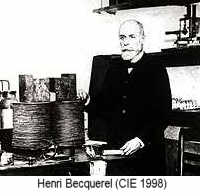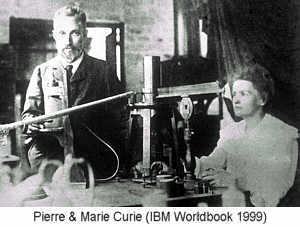History
To put their work in context, it is worth summarising how our present-day model of the atom came about:
- The concept of Atoms dates back to the ancient Greeks. They thought that matter could be made up of tiny building blocks. They imagined that everything was made of combinations of four elements : earth,air, fire, and water.
- Isaac Newton, in 1687, said that the relationships we see between pressure, volume and temperature in gases could be explained if we assume that the gas is made of tiny particles.
 During the 19th Century, the modern idea of elements grew.
During the 19th Century, the modern idea of elements grew.
In 1808, John Dalton suggested that each element was made of identical atoms.
In 1811 Amedeo Avogadro proposed that these atoms could stick together to form molecules.
By 1895 the sheer weight of evidence was that, although they were too small to see, atoms and molecules were real.
- JJ Thomson proposed the "Plum-pudding" model of the atom. (He also discovered the existence of electrons, in 1897). This model was an attempt to explain the discovery of both positive and negative charges within the atom. He said that the negative charges were scattered throughout a positively charged atom, like currants in a bun.
- In 1911, Ernest Rutherford put forward his model of the atom. This proposed that all the positive charges were concentrated in a tiny nucleus, and the electrons orbited around the outside of the atom.
- In 1932, James Chadwick discovered the neutron. The discovery of this uncharged particle explained the large masses of the elements compared to their number of charges.
- There was a problem with the Rutherford model, in that classical electromagnetic theory said that the orbiting electrons ought to radiate energy, their orbits should decay rapidly and they should fall in to the nucleus.
In 1913, Niels Bohr proposed an updated model, which included some modern quantum theory. This allowed for electrons to move in orbits, as in the Rutherford model. Bohr's ideas included electrons only being allowed to follow certain fixed orbits, leading to the concept of electron shells that we use in chemistry.
Our modern understanding of the atom is based on these early models. We now know that protons and neutrons are themselves made of smaller particles called "quarks", and that at the subatomic level, the laws of probability appear to govern the processes.
Henri Becquerel (1852 - 1908) 
In 1896, the French scientist Henri Becquerel discovered that crystals of a Uranium compound would darken photographic plates (like our modern photographic film), even through black paper that kept out all light.
He thought that the compound must have been giving off some other form of radiation, which could pass through the paper. Marie Curie later named this "radioactivity".
He shared the Nobel Prize for Physics with Marie and her husband, Pierre, in 1903.
Becquerel was born in Paris, and studied at the Ecole Polytechnique. In 1892, he became professor of physics at the Museum of Natural History, and in 1895 also at the Ecole Polytechnique. He was elected president of the French Academy of Sciences in 1908.
| Marie and Pierre Curie | |
|
Their work focussed the attention of scientists on this strange new phenomenon and led to a wide range of experiments. A unit of radioactivity is named after Marie: |
Born in Poland as Marie Sklodowska in 1867, from childhood Marie had a remarkable memory. At the age of 16 she started work as a teacher, then as a governess, using her earnings to pay for her sister Bronia's medical studies.
In 1891 she went to Paris, where she studied Physics. In the spring of 1894 she met her husband-to-be, Pierre Curie. Marie began looking for substances that emitted radioactivity. She studied a substance called pitchblende extensively, an ore with a surprisingly high activity.
Pierre joined her in this work, and together they discovered two new radioactive elements, naming them Polonium and Radium. Pierre studied the radiations, whilst Marie worked to obtain a sample of pure Radium. She received her doctorate of science in 1903, and Becquerel & the Curies shared the Nobel Prize for Physics that same year.
Marie had two daughters, Irène and Eve. She was appointed lecturer in Physics at the École Normale Superieure in Sèvres in 1900, and introduced teaching methods based on experimental demonstrations. The sudden death of her husband in a road accident in 1906 was a huge blow to Marie. From then on, she devoted her energy to completing the scientific work they had done together.
In 1911 she was awarded the Nobel Prize for chemistry, having finally isolated pure Radium. Throughout the First World War, Marie and her daughter, Irène, worked on X-radiography. After the war she devoted her researches to discovering medical uses for radioactivity.
In 1934, Marie died of leukaemia caused by her extensive work with radiation. Her contribution to modern Physics was immense. In 1995 her ashes were placed in the Panthéon in Paris, the first woman to receive this honor for her own achievements. Madam Curie and her daughter were considered hot! In fact, they were so hot, their remains are housed in containers lined with 6 inches of lead.
Pierre Curie (1859 - 1906)Pierre was educated by his father, who was a doctor. By the age of 14, he had developed a passion for mathematics, and showed a particular talent for spatial geometry, which was to be useful in his later work on the structure of crystals.
In 1878 Pierre was taken on as a laboratory assistant at the Sorbonne, where he carried out work on the wavelength of Infra-red waves and studied the symmetries of crystals. With his brother, Jacques, he discovered piezoelectricity, in which stresses on a crystal can generate electricity. This is used in modern gas lighters, and small speakers and microphones.
After being appointed as supervisor at the School of Physics and Industrial Chemistry in Paris, he worked on magnetism, leading to the formulation of Curie's Law, which relates a type of magnetic attraction and temperature.
Pierre Curie married Marie Sklodowska in 1895, and they worked together on radioactivity (see above). Pierre concentrated on the radiations themselves, and used magnetic effects to prove that radioactive substances gave off positive, negative and neutral rays. Ernest Rutherford was later to name these alpha particles, beta particles, and gamma rays.
Pierre also observed the effects of radiation on the body, laying the foundations for radiotherapy, used in modern cancer treatments. He refused a post at the University of Geneva in order to continue his work with Marie. In 1904 he was appointed professor at the Sorbonne, and was elected to the Academy of Sciences in 1905, having jointly received the Nobel Prize for Physics with Marie Curie and Henri Becquerel in 1903.
He was killed instantly when he was run over by a cart in the Rue Dauphine in Paris in 1906. Pierre Curie was one of the founders of modern Physics.
Lord Ernest Rutherford (1871 - 1937)
Born in Spring Grove, New Zealand, Ernest was the fourth of twelve children. His parents, who had emigrated from Britain, lived simply in order to be able to afford to educate their children.
In 1887 Ernest won a scholarship to Nelson College, where he went on to win prizes in history, languages, and mathematics. With the aid of another scholarship he gained a place at Canterbury College, Christchurch, and graduated in 1892 with first-class honours in mathematics and physics. Staying on, he taught part-time to fund his research into magnetic fields. He discovered that he could detect the then newly-discovered radio waves even after they had passed through brick walls.
Before leaving New Zealand for England, he became unofficially engaged to Mary Newton, a daughter of his landlady in Christchurch. He wrote her many letters from England, which have been preserved and today tell us much about this fascinating personality.
Arriving in Cambridge in 1895, Rutherford began work under JJ Thomson at the Cavendish Laboratory, where he made a great impression on colleagues. The story goes that he had such a loud voice that he disturbed experiments in the Cavendish and they had to hang up "Quiet Please" signs.
Following work on X-rays, Rutherford studied the rays emitted from Uranium compounds discovered by Henri Becquerel. He showed that they were different to X-rays, that they ionised air and were made of charged particles. We now know them as alpha and beta particles.
In 1898 Rutherford was appointed to the chair of physics at McGill University in Montreal, and in the summer of 1900 he travelled to New Zealand to marry Mary Newton. When their first daughter was born, he wrote to his mother that" ... it is suggested that I call her ' Ione' , after my respect for ions in gases".
"Rutherford's Experiment" provided the most important evidence for the internal structure of the atom.
Geiger and Marsden, working for Rutherford, performed an experiment in which alpha particles were fired at a very thin gold foil. They found that the vast majority of the particles passed straight through, and that only a few were deflected off-course. Even fewer were deflected back the way that they came.
This led him to the conclusion that the atom had a tiny, dense, positively-charged nucleus. Anything lighter would not be able to repel heavy alpha particles back the way they came. Thus the negatively-charged electrons must be somewhere around the outside of the atom.
He also discovered that radioactive decay is not affected by external conditions.
Rutherford was elected president of the Royal Society in 1925, and made many other significant contributions in the field of physics. In 1931 he was made a peer. He died in Cambridge in 1937, following a short illness, and was buried in Westminster Abbey.
Hans Geiger (1882 - 1945)
Johannes Wilhelm Geiger was a German physicist who introduced the first reliable detector for alpha particles and other ionising radiation. We still use his basic design today, although more advanced detectors are also in use.
Geiger gained his PhD at the University of Erlangen in 1906, then joined the University of Manchester, becoming one of Ernest Rutherford's most valued colleagues. Here he built his first particle counter and used it in experiments that identified alpha particles as being the same as the nucleus of a Helium atom.
In 1912 he moved to the German National Institute for Science and Technology, where he continued to study atomic structure. Geiger served as an artillery officer during the First World War.
He accepted his first teaching position in 1925 at the University of Kiel, where he worked with Walther Müller to improve the sensitivity and performance of his particle counter. The modern Geiger-Müller tube detects both alpha and beta radiation, along with other photons.
In 1929 Geiger moved to the University of Tübingen, where he investigated cosmic rays, moving on to the Technische Hochschule in Berlin in 1936 to work with nuclear fission and artificial radioactivity, until his death in 1945.
Walter
































No comments:
Post a Comment